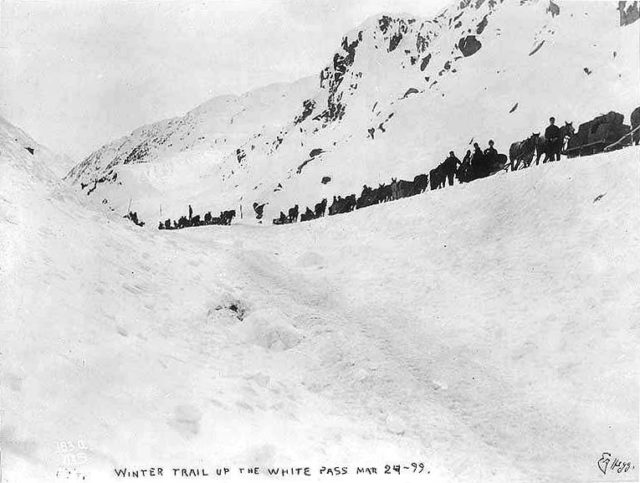No written document exists that clearly speaks of Dyea’s infancy, however it seems that it started out as a Chilkoot village, later becoming a seasonal fishing camp and safe landing stage for boats. The name itself derives from the Tlingit word Dayéi, which roughly translated means “to pack.” Today the abandoned town is designated a National Historic Landmark.
Located in Alaska, at the convergence the Taiya River and Taiya Inlet, Dyea boomed as the main staging post for prospectors who came to travel the Chilkoot Pass trail during the Klondike Gold Rush of 1896 to 1899.
Because Canadian authorities insisted that the prospectors carried with them a years supply of provisions, they left from Seattle with up to a ton of supplies which had to be transported first by boat to Skagway and Dyea, then by foot for the 500 mile mountainous trek to Dawson City and the Yukon gold fields.

This mountain pass was of immense importance for trading, and as a route for prospectors to hunt down their dreams. The Chilkoot Trail allowed them to attempt the arduous journey from the coast to Bennett Lake and the headwaters of the Yukon River, many led by Tlingit guides who made good money during the gold rush years.

With nothing but a promise of a better tomorrow through hearsay and newspaper reports, less than one third of the 100,000 prospectors who set out for Klondike arrived at their destination. The most popular routes were to begin from either Dyea from where the Chilkoot Pass awaited, or Skagway and the White Pass.


Up until 1897, Dyea was a peaceful place, quiet and undisturbed. But once a word of a gold and riches began to spread all across America, Dyea’s peace was no more.
“As word of the strike spread, stampeders began to trickle into the area. By that winter, the trickle had turned into a flood as thousands of stampeders slogged through the muddy streets, eating and sleeping in quickly-built restaurants and hotels” writes the Smithsonian National Postal Museum.

At first, Dyea’s only store was the Healy & Wilson trading post, established by John J. Healy and Edgar Wilson in the mid-1880s. When news of the Klondike gold strike spread, a cluster of tents quickly sprang up as people left everything behind to try their luck. Once winter came and the mountain trails became impassable, Dyea’s population started to grow — rivers of people came to overwinter in Dyea and the town grew larger by the day.

By the winter of 1897-8 a downtown as wide as five blocks had formed and now Dyea had a total of 150 different business scattered up and down its streets; hotels, restaurants, and saloons welcomed all who had a couple of cents to spare. Dyea also had its fair share of bankers and attorneys and photographers. There were even real estate agents, a hospital, doctors and dentists.

Given its location, Dyea needed a way to stay in touch with the rest of the world, and for that purpose two telephone companies were formed, as well as two new agencies, the Dyea Press and Dyea Trail. During the winter months Dyea thrived, but once warm weather and sun began to melt the snow, this town was nearing its end. It was starting to lose in the competition with Skagway as the prime base from which to journey into the interior of Canada. In April 1898, the town of Dyea was hit by what was known as the “Palm Sunday Avalanche” — a natural calamity that took the life of 70 people, as well as the reputation of Dyea.


Discouraged by the event, people turned towards Skagway and the White Pass. Once the White Pass and Yukon Route railroad was constructed in 1898, the Chilkoot Trail attracted less and less hopeful prospectors. In 1899, a massive forest fire destroyed the U.S Army Camp that was located near Dyea and played an important part in Dyea’s existence. On top of it all, America’s newspapers tired of reporting about the gold fields. Strikes elsewhere in Canada began to entice people to embark on different journeys and Dyea met its end.

At the turn of the century, Dyea’s population dropped down to 250 citizens, and in 1901 there were barely 70 people living there. Nowadays, this historical place is a mere ghost town inside of the Klondike Gold Rush Historical Park, with decaying wooden buildings and colorful history of the days when no ice could stop a man on his way to riches.
